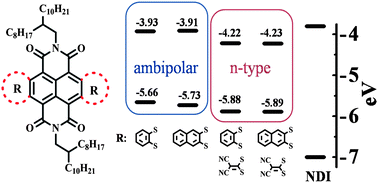In this paper, we report four new core-extended NDI molecules 1, 2, 3 and 4. 1 and 2 entail two benzene rings and two naphthalene rings, respectively; 3 and 4 contain benzene and naphthalene rings as well as 2-(1,3-dithiol-2-ylidene)malonitrile groups. All of them can be easily synthesized with acceptable yields. HOMO/LUMO energies of 1, 2, 3 and 4 were −5.66 eV/−3.93 eV, −5.73 eV/−3.91 eV, −5.88 eV/−4.22 eV and −5.89 eV/−4.23 eV, respectively. OFETs with thin-films of 1, 2, 3 and 4 were successfully fabricated with conventional techniques. Thin-films of 1 and 2 exhibit ambipolar semiconducting properties under N2 atmosphere with relatively balanced hole and electron mobilities, which can further increase after annealing; hole and electron mobilities reach 0.047 and 0.016 cm2 V−1 s−1, respectively for the thin-film of 2 after annealing at 140 °C. Moreover, two identical ambipolar transistors with thin films of 2 were combined into an inverter circuit with a gain of 11. 3 and 4 behave as n-type semiconductors in air, and the electron mobility can reach 0.22 cm2 V−1 s−1 for the thin-film of 3 with an Ion/off of 106 after annealing at 120 °C. XRD and AFM studies are also presented for understanding the variation of carrier mobilities of thin-films of 1, 2, 3 and 4 after annealing at different temperatures.


 Please wait while we load your content...
Please wait while we load your content...